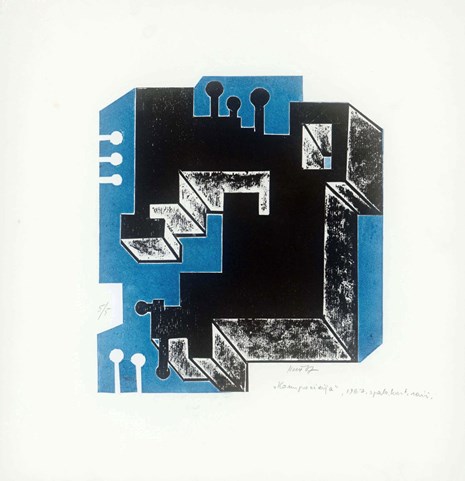Vincas Kisarauskas

A Retrospective of Work by Vincas Kisarauskas (1938-1988). Greeting the Time
Vincas Kisarauskas is one of the most prominent modernist artists of Lithuania, whose creative work and public cultural initiatives had a profound influence on his contemporaries and the development of modernism. The creative legacy of Vincas Kisarauskas, a tremendously prolific and versatile artist, is unique in Soviet-Lithuanian art. He wanted his work to be in tune with the general context of Western art, and dreamt of seeing it exhibited in the West. Kisarauskas' life shows the great pains he took to ensure that his works were relevant and contextual. He had the power to change the artistic thinking of his times.
Kisarauskas was born in 1934, in the village of Augmėnai in the Radviliškis district. After studying ceramics at the Telšiai Trade School of Applied Arts, he enrolled in the Textile Department of Vilnius Art Institute. A year and a half later, he transferred to the Painting Department, from which he graduated in 1959. He attracted public attention for the first time in 1961, when he held a solo exhibition of paintings and graphic works at the Writers' Union Club in Vilnius. Before that, he had illustrated Julius Janonis' children's book 'Poklius Lies in Wait Every Day' (1960). His first exhibition was shut down by the authorities, while his illustrations for the book were criticised in the press for their alleged formalism. In 1963, the KGB noted in its records that Kisarauskas' work had 'a negative influence on young people, particularly students at the Art Institute'. For a long time, his work remained on the margins of official Soviet art life; its presentation and dissemination were severely restricted by censorship, and in effect it was accessible only to a small audience. In addition, his own self-critical attitude prevented many of his works from crossing the doorstep of his studio. Kisarauskas passed away in 1988 in New York.
This retrospective of his work presents innovative ideas, of which the content and the form may have influenced artistic thinking and notions of art in their time. Kisarauskas' non-conformist stance is associated not just with resistance to the official art canon, but also with his critical attitude towards political ideology and the processes of sovietisation. Along with his constructivist (conceptual) paintings, which are relevant to the development of Lithuanian modernism, the exhibition showcases another important sphere of his experimental activity: small-format paintings, diary-like sketchbooks, an unrealised theatrical project, works of applied graphics, book illustrations, collages, impromptu pieces and sketches.
Curator Milda Žvirblytė
Sponsors: Culture Council of
Lithuania, Culture Ministry of the Republic of Lithuania, VšĮ
Pirmoji kava, Exterus, Ekspobalta
Media support: Lietuvos rytas,
lrytas.lt


